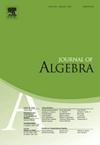Fundamental polytope for the isometry group of an alcove
IF 0.8
2区 数学
Q2 MATHEMATICS
引用次数: 0
Abstract
A fundamental alcove is a tile in a paving of a vector space V by an affine reflection group . Its geometry encodes essential features of , such as its affine Dynkin diagram and fundamental group Ω. In this article we investigate its full isometry group . It is well known that the isometry group of a regular polyhedron is generated by hyperplane reflections on its faces. Being a simplex, an alcove is the simplest of polyhedra, nevertheless it is seldom a regular one. In our first main result we show that is isomorphic to . Building on this connection, we establish that is an abstract Coxeter group, with generators given by affine isometric involutions of the ambient space. Although these involutions are seldom reflections, our second main result leverages them to construct, by slicing the Komrakov–Premet fundamental polytope for the action of Ω, a family of fundamental polytopes for the action of on , whose vertices are contained in the vertices of and whose faces are parametrized by the so-called balanced minuscule roots, which we introduce here. In an appendix, we discuss some related negative results on stratified centralizers and equivariant triangulations.
凹形的等距群的基本多面体
基本凹形A是由仿射反射群Waff在向量空间V上铺砌的一块砖。它的几何结构编码了Waff的基本特征,如它的仿射动力学图D ~和基本群Ω。本文研究了它的全等距群Aut(A)。众所周知,正多面体的等距群是由其表面的超平面反射产生的。作为一个单纯形,凹形a是最简单的多面体,然而它很少是正面体。在我们的第一个主要结果中,我们证明了Aut(A)与Aut(D ~)是同构的。在此联系的基础上,我们建立了Aut(A)是一个抽象的Coxeter群,其生成器由环境空间的仿射等距对合给出。虽然这些对合很少是反射,但我们的第二个主要结果利用它们来构建,通过切割用于Ω作用的Komrakov-Premet基本多面体K,用于Aut(a)作用于a的基本多面体族,其顶点包含在K的顶点中,其面由我们在这里介绍的所谓平衡极小根参数化。在附录中,我们讨论了关于分层中心化器和等变三角剖分的一些相关的否定结果。
本文章由计算机程序翻译,如有差异,请以英文原文为准。
求助全文
约1分钟内获得全文
求助全文
来源期刊

Journal of Algebra
数学-数学
CiteScore
1.50
自引率
22.20%
发文量
414
审稿时长
2-4 weeks
期刊介绍:
The Journal of Algebra is a leading international journal and publishes papers that demonstrate high quality research results in algebra and related computational aspects. Only the very best and most interesting papers are to be considered for publication in the journal. With this in mind, it is important that the contribution offer a substantial result that will have a lasting effect upon the field. The journal also seeks work that presents innovative techniques that offer promising results for future research.
 求助内容:
求助内容: 应助结果提醒方式:
应助结果提醒方式:


